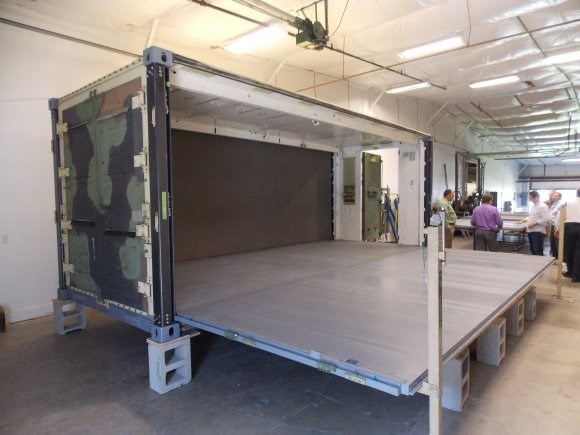U.S. Army uses composites to refurbish aging wall shelters
The rigid wall shelters are used for the core parts of Army field hospitals, housing the operating room, the C-arm (portable radiology), and the laboratory, where the floor must be stable and free of vibration.

A carbon composite retrofit kit will be used to refurbish and address deficiencies in the current rigid wall shelters. (Photo Credit: Barbara Romiti, USAMMDA)
The U.S. Army Medical Materiel Development Activity's Medical Support Systems Project Management Office is updating rigid wall shelters, an integral part of Army field hospitals, according to a news release from the Army. Working in coordination with Melvin Jee and Roger Masadi of the Tactical Shelters Team, Army Natick Soldier Research, Development & Engineering Center and also Core Composites, a division of ROM Development Corp. in Bristol, Rhode Island, the MSS PMO will use a carbon composite retrofit kit to refurbish the current shelters and address the deficiencies.
"Carbon composite is two times stiffer and, overall, the shelter will be 20 percent lighter than the current aluminum design," says Richard O'Meara of Core Composites, a division of ROM Development Corporation.
The rigid wall shelters are used for the core parts of Army field hospitals, housing the operating room, the C-arm (portable radiology), and the laboratory, where the floor must be stable and free of vibration. According to Jaime Lee, MSS PMO product manager, the kit will address instability problems for rigid wall shelters.
"We kind of fixed it by placing scissor-jacks underneath the middle section of the shelter," Lee says. "This works for a while until the ground settles."
The kit provides a single fixed floor with two expandable floors. Constructed with carbon composite, they are double the stiffness of the previous floors, which makes them less susceptible to unwanted vibration.
Also included are four vertical corner posts fabricated out of carbon composite. Each post only weighs 50 pounds, as opposed to the current aluminum post, which weighs 71 pounds. These posts bear the load of additional containers stacked on top of the shelter.
Currently, each aluminum corner post is designed to support 100,800 pounds, which allows for the shipping containers to be transported in a six-high stack. The carbon composite corner posts are designed to meet the current transportation standards, which require each corner post to support 211,675 pounds in order to withstand the weight of eight shipping containers resulting in a nine-high stack. This increased capability improves transportation efficiency and will reduce the cost of shipping.
Additionally, when taken as a whole, the reduced panel and corner post weights serve to lower the overall empty shelter weight by several hundred pounds. This allows for an increase in the amount of cargo the shelter can carry.
According to O'Meara, the posts are also much more corrosion-resistant than the current aluminum posts, which corrode when in contact with the steel corner fittings.
In the past, shelter refurbishment has involved more of a facelift approach: the floors are redone, and the shelter is painted and resealed. Now, Core Composites, a division of ROM Development Corp., will make the retrofit kits and send them to Defense Depot Hill Utah. There, the original shelter will be disassembled and more than half of the major components will be replaced using the new kit.
Also, since current shelters are not energy-efficient, Tnemec's Aerolon 945 will be applied to the ceiling as either a sprayed-on coating or a peel-and-stick "wallpaper," which will provide better insulation, thereby reducing heat and cold loss through the top of the shelter. This will double the insulation efficiency of the shelter. According to Lee, the retrofitting of 24 shelters using FY16 funding will begin in fiscal year 2017 and continue with 24 shelter retrofits per year, subject to the availability of funding.
"We are procuring the kits now as an engineering change proposal to the original shelter," says Lee. "In two years, we will reassess and do a cost-benefit analysis to see if we should just replace the entire shelter with a carbon composite shelter. It might be just as cost-effective to stay with the kit."
Related Content
McLaren celebrates 10 years of the McLaren P1 hybrid hypercar
Lightweight carbon fiber construction, Formula 1-inspired aerodynamics and high-performance hybrid powertrain technologies hallmark this hybrid vehicle, serve as a springboard for new race cars.
Read MorePEEK vs. PEKK vs. PAEK and continuous compression molding
Suppliers of thermoplastics and carbon fiber chime in regarding PEEK vs. PEKK, and now PAEK, as well as in-situ consolidation — the supply chain for thermoplastic tape composites continues to evolve.
Read MorePlant tour: Joby Aviation, Marina, Calif., U.S.
As the advanced air mobility market begins to take shape, market leader Joby Aviation works to industrialize composites manufacturing for its first-generation, composites-intensive, all-electric air taxi.
Read MoreInfinite Composites: Type V tanks for space, hydrogen, automotive and more
After a decade of proving its linerless, weight-saving composite tanks with NASA and more than 30 aerospace companies, this CryoSphere pioneer is scaling for growth in commercial space and sustainable transportation on Earth.
Read MoreRead Next
“Structured air” TPS safeguards composite structures
Powered by an 85% air/15% pure polyimide aerogel, Blueshift’s novel material system protects structures during transient thermal events from -200°C to beyond 2400°C for rockets, battery boxes and more.
Read MoreVIDEO: High-volume processing for fiberglass components
Cannon Ergos, a company specializing in high-ton presses and equipment for composites fabrication and plastics processing, displayed automotive and industrial components at CAMX 2024.
Read MorePlant tour: Daher Shap’in TechCenter and composites production plant, Saint-Aignan-de-Grandlieu, France
Co-located R&D and production advance OOA thermosets, thermoplastics, welding, recycling and digital technologies for faster processing and certification of lighter, more sustainable composites.
Read More






















